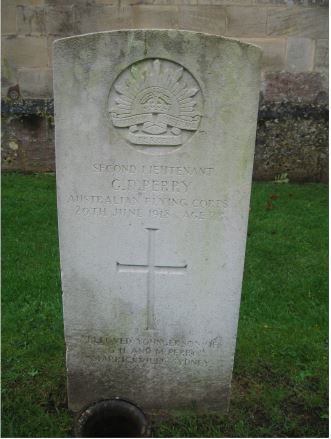2nd Squadron, Australian Flying Corps

Gilbert Douglas Perry was born at Petersham, Sydney, New South Wales (NSW) in 1893, the son of G A and M Perry, who lived at 247 Marrickville Road, Marrickville, Sydney, NSW.
He was a civil engineer and surveyor when he enlisted at Sydney on 9 March 1915, declaring that he had previously served with 16 Signal Troop, Australian Engineers.
His initial posting was to 4 Signal Troop, Engineers as a Sapper. He embarked from Australia, bound for Egypt, on the troopship Merville on 31 May 1915, arriving on 17 July 1915. On 21 August he joined 2 Signal Company and on 2 September transferred to 2 Division Signal Company Mediterranean Expeditionary Force Order. It would appear that he saw service at Gallipoli as his service record notes that on 28 October he was admitted to 5 Field Ambulance with tonsillitis whilst at Anzac. He was evacuated to Alexandria on board the hospital ship Nevasa in early November and admitted to the General Hospital with diphtheria. His stay in hospital lasted until 28 November, when he transferred to the Ras-el-tin Hospital in Alexandria.
On 27 January 1916 he had returned to duty with 2nd Australian Division Signals and on 6 March he transferred to 4th Australian Division Signal Company. A further transfer occurred on 13 May 1916 when he moved to 13 Field Company Engineers as a Sapper (with the number 1010). This was the prelude to sailing (on the troopship Oriana) from Alexandria to Marseilles on 6 June 1916 to join up with the 13 Field Company on the Western Front.
From 2 September to 14 September 1916 he spent time in the 3rd Canadian Stationery Hospital at Rouen with what was described as ‘myalgia’, following this he was at 4th Australian Base Depot at Etaples, before rejoining the 13 Field Company on 18 October 1916. A further year was spent with this unit before Sapper Perry decided to try his luck with the fledgling Australian Flying Corps (AFC), transferring to them as a Second Air Mechanic on 26 October 1917. On 2 November he was appointed as a Cadet and placed at No 1 Royal Flying Corps School of Military Aeronautics, Reading, followed by an attachment for elementary instruction to No 5 Training Squadron, AFC at Minchinhampton in Gloucestershire.
During his time at Minchinhampton, Cadet Perry experienced flying in several types. Initially he logged eight hours 30 minutes with an instructor on the DH6, followed by 15 hours similarly on an unspecified Avro machine. He first went solo on one of these and had logged 13½ hours before he moved on to flying the Sopwith Pup, where 10½ hours were logged. During this time, on 25 May 1918, he was appointed Second Lieutenant (or Flying Officer).
By 21 June 1918 2nd Lieutenant Perry had logged three hours fifteen minutes solo in the Sopwith Camel fighter. At 10.50am on that day he took off, in Camel No C103, in good weather. The aircraft was set up for practising diving in preparation for firing at an aerodrome target. By 1918 the tactics employed on the Western Front were very much ‘all arms’ and aircraft were being increasingly used in support of infantry. Lieutenant S H Harper, Commander of ‘A’ Flight, 5th Training Squadron and Perry’s instructor was a witness to what happened next.
He watched Perry’s Camel diving onto the target at about 150 mph. When down to about 500 feet the pilot appeared to pull out too suddenly from the dive. After that the machine zoomed and Harper observed the right hand plane (bottom wing) fold in two, followed shortly after by the right hand top plane. The machine went into a slow spin to the right and crashed into a tree on the eastern side of the aerodrome. Perry had survived the crash with facial injuries and his left leg broken above the ankle. He was taken from the cockpit and immediately rushed to the Cottage Hospital in Tetbury.
A Court of Inquiry held that day concluded that the crash was due to bad piloting, Second Lieutenant Perry having pulled the aircraft out of a steep dive too roughly thereby causing undue strain and so breaking the right hand wings.
Gilbert Perry’s injuries proved too extensive to enable him to recover. He hung on in the hospital for a further eight days before he died at 8.45pm on 29 June 1918, aged 23. He was afforded a full military funeral and laid to rest in Tetbury (St Saviour’s Churchyard) where a standard CWGC headstone now marks his grave.
Researched by Graham Adams 12 March 2013
